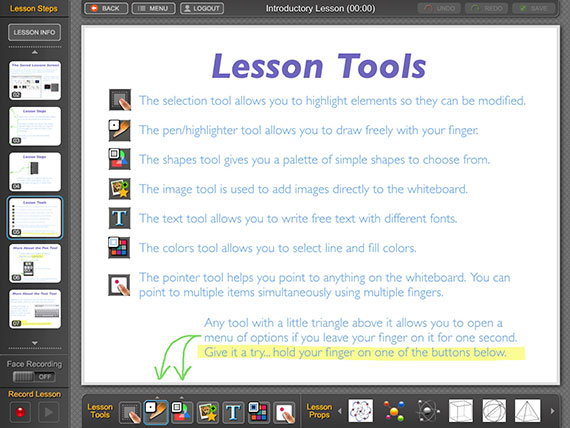Free App Lets Teachers Create High Quality Flipped Video on iPads
- By Bridget McCrea
- 10/09/13

Knowmia Teach lets users record lessons using slides, audio, and video. |
Natasha Rausch is the first to admit that her first two attempts at creating video lessons from scratch were crude at best. “I used a cheap screencast download and filmed myself over a PowerPoint presentation that I’d made,” recalled Rausch, who teaches English and social studies to middle and high school students at Walden School/The Learning Center for the Deaf in Framingham, MA.
“It took me hours to make and it looked horrible—like a B movie.”
Intent on flipping her classroom, Rausch started looking for a better way to produce content. Ideally, she wanted a whiteboard-type app that would allow her to create the flipped classroom presentations. That was a tall order for a teacher of deaf students. “All whiteboard apps at the time were audio-only,” Rausch said.
Ask and You Shall Receive
Having taught with iPads since 2011, she was introduced to Knowmia Teach, a free iPad app, at a summer workshop. Teachers use the app to create dynamic video presentations and publish them on the app's website. Rausch took an interest in the app that went beyond simply downloading it and using it. “I suggested that Knowmia find a way to incorporate a camera and video recording option so teachers could record themselves over the slides explaining their lessons,” said Rausch.
Within a few weeks, the provider added the FaceTime feature and then over the following year made it even more accessible. Today, Rausch can change the size of her video recording or the placement of a video clip to meet the needs of her students with vision issues. In her classroom, Rausch uses the app to make homework videos, condense textbook sections and chapters down into reviewable chunks, and create clips that help students study for tests.
For her reading classes, Rausch makes videos that require the students to read a specific text first and then to watch a video. In the clip she asks (in American Sign Language or ASL) short-answer questions related to the story. Students can either write down their answers in English or make their own video responses to the questions.
Rausch also uses Knowmia to plan ahead for her own absences. “I’ve put together entire lessons for my students to complete as homework, or even better, when I'm absent,” said Rausch. “Instead of leaving ‘busy work,’ I have pre-made activities they can complete on iPads or laptops so they're not missing valuable instruction time.”
Flipped Learning 101
Eager to cultivate more productive classroom environments, K-12 teachers like Rausch are always on the lookout for apps that help them reach that goal in the most efficient manner possible. Add the words “flipped” and “free” to the mix—and then make the apps iPad-compatible—and the proposition becomes difficult for instructors to resist.
Scott Haselwood, a secondary math teacher at Edmond Memorial High School in Edmond, OK, is one such instructor. When his school invested in a mobile cart equipped with 40 iPads and a new Wi-Fi setup in 2012, Haselwood said he immediately started looking for a way to flip his classroom.
With students blocked from using YouTube on campus, he needed an alternate way to publish the classroom content for students. After hearing about Knowmia from a colleague on Edmodo, Haselwood downloaded and tested it out. Today, he uses the app to record class notes, sample math problems, and lessons in advance. He uses either Edmodo or Twitter to share the video links with students, and gives them a few days to watch the videos.
“When they get to class I give them a blank outline that they have to fill in on their iPads,” said Haselwood. “That makes it pretty easy to see who has taken the time to do their ‘homework’ and who hasn’t.” Making sure students don’t fall into the second category isn’t always easy—particularly with a challenging subject like math. Left to their own devices to study ahead, for example, some will inevitably choose to wait until they get to class to learn the material."
Reaping the Rewards
Haselwood said the extra effort required to get students on task in the flipped classroom environment is well worth it. “With this setup—which allows students to Tweet me when they need my help, for example—I can be with my pupils 24/7,” said Haselwood, “and they can learn when they are ready to learn; not when it’s forced upon them.”
Rausch, whose biggest challenge in the flipped classroom environment is a lack of time needed to produce content across the various courses that she teaches, has also realized benefits from using Knowmia. “It has really cut down on all the guesswork and streamlined the process of making video lessons,” she said. “It makes the content more accessible and clear for my students, who can see the information presented in ASL and watch, pause, and rewind as needed. It’s really invaluable.”
About the Author
Bridget McCrea is a business and technology writer in Clearwater, FL. She can be reached at [email protected].